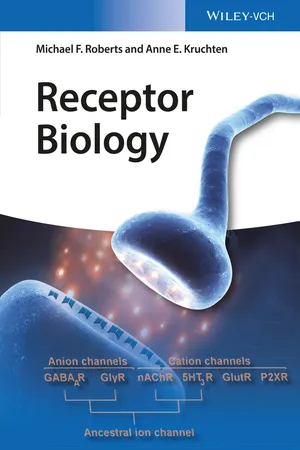
- English
- ePUB (mobile friendly)
- Available on iOS & Android
Receptor Biology
About This Book
This book is geared to every student in biology, pharmacy and medicine who needs to become familiar with receptor mediated signaling. The text starts with explaining some basics in membrane biochemistry, hormone biology and the concept of receptor based signaling as the main form of communication between cells and of cells with the environment. It goes on covering each receptor superfamily in detail including their structure and evolutionary context. The last part focusses exclusively on examples where thorough knowledge of receptors is critical: pharmaceutical research, developmental biology, neurobiology and evolutionary biology. Richly illustrated, the book is perfectly suited for all courses covering receptor based signaling, regardless whether they are part of the biology, medicine or pharmacology program.
Frequently asked questions
Information
Part I
Introduction
Chapter 1
Introduction
The beauty of reductionism is that it gives you something to do next.
- Sperm and egg meet, recognize each other, and bind by a receptor mechanism.
- Embryos develop by cell communication: one cell releases a hormone that binds to a receptor on another cell, and the second cell changes its shape and function, initiating the process of differentiation.
- Hormone-like neurotransmitters are released from one cell (a nerve) and bind to receptors on the surface of a nearby cell (another nerve or a muscle) to cause thought or movement.
- The digestive system propels food and releases enzymes according to the binding of hormones to cells lining the digestive tract.
- Immune system cells contain on their surfaces receptors that are able to recognize foreign proteins and attack invading cells.
- Diseases often act by subverting normal receptor function.
1.1 Receptors and Signaling
1.1.1 General Aspects of Signaling
1.1.2 Verbal and Physiological Signals
- The sender must relay a characteristic signal, and it must be received by a characteristic device;
- The signal is arbitrary: it bears no real relation to the process it starts but is simply a way of obtaining a response in the receiver;
- The signal is simpler than the process it sets in motion.
- The signals are the words of the language, and the receiver is the hearing/thinking/acting apparatus of another person;
- Each language uses different words, yet all people can express the same thoughts.
- Any word (e.g., HELP) evokes in its hearer a set of thoughts or behaviors that are much more complex than the word itself.
- The correct signal is the drug or hormone, the correct receiver is the cell surface receptor or nuclear receptor.
- It is arbitrary that one amino acid (e.g., glutamic acid) is an excitatory transmitter in the nervous system, whereas another amino acid (e.g., glycine) is an inhibitory transmitter.
- The binding of a single transmitter molecule to its receptor is adequate to start a cascade of intracellular events that amplifies the signal into a complex biochemical response.
- The receptor must be present on the correct tissue, it must be selective or specific to the hormone, and the receptor must not be present in tissues where the response is not desired; thus, the timing of the message must be coordinated with the presence of the receptor for that message.
- The signal must always mean the same thing to a particular receptor–effector mechanism.
- Some transmitters act on more than one type of receptor, often activating antagonistic cellular processes.
1.1.3 Criteria for Recognizing Transmitters and Receptors
1.1.4 Agonists
- be synthesized, stored, and released from the proper type of cell (e.g., neuron or endocrine cell);
- have a specific mechanism for removal from the extracellular space near the target cell;
- be effective as an agonist if added to the target cell by experimenters.
1.1.5 Receptors
- be activated by one or only a few substances;
- bind these substances with high affinity;
- be able to transmit the binding event to the cell interior.
1.1.6 Receptor–Enzyme Similarities
- A receptor-binding event has no “product” because the agonist is unaltered by its interaction with the receptor.
- The receptor–agonist complex has an additional role after binding: the conversion of the binding signal to an intracellular event, such as enzyme activation or gene transcription.
1.2 Types of Receptors and Hormones
1.2.1 R...
Table of contents
- Cover
- Title Page
- Copyright
- Dedication
- Table of Contents
- Acknowledgments
- Part I: Introduction
- Part II: Fundamentals
- Part III: Receptor Types and Function
- Part IV: Applications
- Glossary
- References
- Index
- End User License Agreement